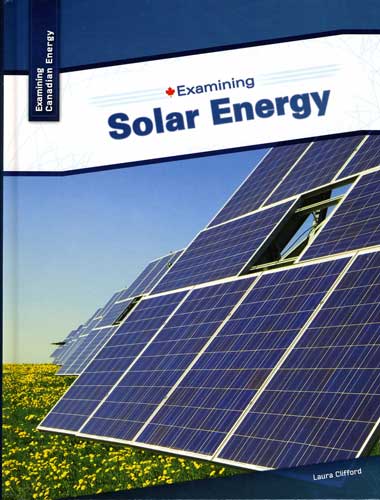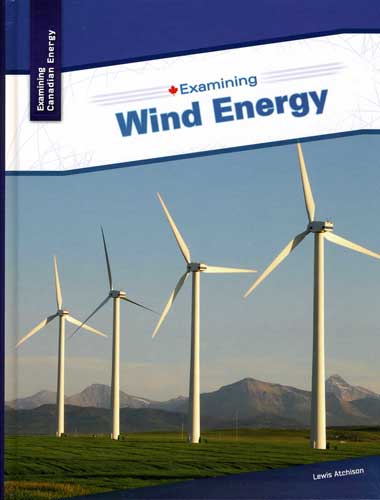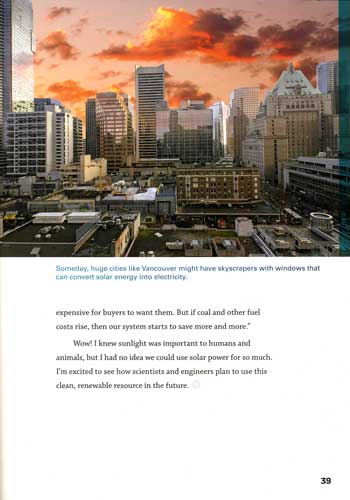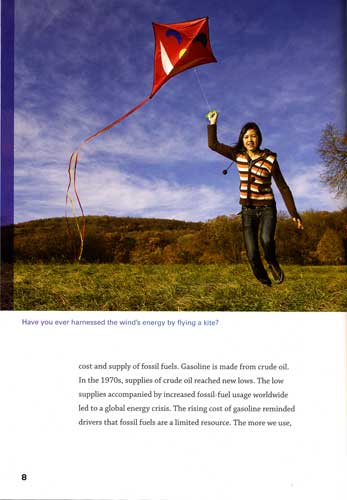| ________________
CM . . .
. Volume XXI Number 29 . . . . April 3, 2015

 |
Examining Solar Energy. (Examining Canadian Energy).
Laura Clifford.
Collingwood, ON: Saunders Book Co., 2015.
48 pp., pbk., hc. & html, $13.95 (pbk.), $26.95 (hc.).
ISBN 978-1-77092-283-9 (pbk.), ISBN 978-1-77092-275-4 (hc.), ISBN 978-1-77092-291-4 (html).
Subject Heading:
Solar energy-Canada-Juvenile literature.
Grades 5-8 / Ages 10-13.
Review by Andrew Laudicina.
***1/2 /4
|
| |
|
 |
Examining Wind Energy. (Examining Canadian Energy).
Lewis Atchison.
Collingwood, ON: Saunders Book Co., 2015.
48 pp., pbk., hc. & html, $13.95 (pbk.), $26.95 (hc.).
ISBN 978-1-77092-285-3 (pbk.), ISBN 978-1-77092-277-8 (hc.), ISBN 978-1-77092-293-8 (html).
Subject Heading:
Wind power-Canada-Juvenile literature.
Grades 5-8 / Ages 10-13.
Review by Andrew Laudicina.
***1/2 /4
|
| |

excerpt:
“Are you on the grid?” I ask.
“Yes and no,” says Rashi. She points down the path to a small house with solar panels on the roof. “This is my house. On sunny days, the panels make electricity that replaces some of the power I would get from the grid. I also dry my laundry in the yard and conserve energy whenever I can. Those are some of my energy adaptations,” she says.
But with a computer, lights, air conditioning, and other appliances, she says the panels can’t do the whole job. She saves money by reducing the amount of electricity she buys, but she is still on the grid.
A few more blocks of walking, and we come upon a small grocery store. “This is my parents’ store,” says Rashi. “They’re adapting to energy limits, too.” The whole flat roof is covered with solar panels. “Take a look at this electric meter.”
…Rashi says, “On most days, my parents’ solar panels make more energy than my parents need. They sell the extra power back to the utility company.” (From Examining Solar Energy.)
Katrina says the system works pretty well, but transporting the electric current can be really expensive. Since most wind farms are located away from residential areas, many kilometres of wires are needed to move the power from the wind farm to a home.
I still don’t see what this has to do with an abandoned mine pits. By now, I’ve taken a rest on a large rock, but Katrina is just getting warmed up. “You see, if wind were always blowing at the same speed in the same place, it could supply a steady stream of electricity. But wind is not that steady. And you need different amounts of electricity at different times.”
Katrina continues, “To make a long story short, we hope to use mine pits such as this one to store electricity generated by wind. Wind often blows strongest at night. We would use this extra energy to pump water from the pit uphill to a storage basin.” I immediately think of the windmill I visited in Holland. It did the very same thing. Katrina goes on to explain that during the day, the water would be released. The rush of water would create energy of its own, ready to meet the demand of customers. (From Examining Wind Energy.)
 This pair of aptly titled books, which belong to the “Examining Canadian Energy” series, invite readers to investigate the various sources of energy they use to power their homes and communities. Narratives, based on the fictional research journals of enterprising students, inform readers of the science behind each energy source in question, including an exploration of its development and use throughout history, as well as an explanation of its present application and future potential. In following this format, every chapter features interactions with a new set of professionals whose expertise vary considerably but are each, nonetheless, important for the breadth of knowledge they impart. Preceding this main narrative, an opening chapter frames each book topic within the context of renewable and nonrenewable sources of energy, environmental degradation and climate change, and notions of cost and demand. A concluding chapter offers a summary of main points covered, along with a series of questions which encourage rigorous discussion. A glossary, activity page, relevant books and weblinks are included to promote independent learning. This pair of aptly titled books, which belong to the “Examining Canadian Energy” series, invite readers to investigate the various sources of energy they use to power their homes and communities. Narratives, based on the fictional research journals of enterprising students, inform readers of the science behind each energy source in question, including an exploration of its development and use throughout history, as well as an explanation of its present application and future potential. In following this format, every chapter features interactions with a new set of professionals whose expertise vary considerably but are each, nonetheless, important for the breadth of knowledge they impart. Preceding this main narrative, an opening chapter frames each book topic within the context of renewable and nonrenewable sources of energy, environmental degradation and climate change, and notions of cost and demand. A concluding chapter offers a summary of main points covered, along with a series of questions which encourage rigorous discussion. A glossary, activity page, relevant books and weblinks are included to promote independent learning.
In Examining Solar Energy, Sage Cooper (the book’s narrator) is researching the merits of solar power to help her school decide if the installation of solar panels would be a wise investment. Her first interview takes her to the Ontario Science Centre and Dr. Ben Mitchell, a solar astronomer, who explains the type of energy emitted by the sun, and how the origins of fossil fuels can be traced back to the remains of “plants and animals that died long ago…” which under “[h]eat and pressure from overlying rocks turned them into carbon rich energy sources we can burn to run factories.” On her fact finding mission, Sage also travels to British Columbia’s Okanagan Valley, the Yukon, rural Alberta (to visit a solar farm), and Quebec (where she tours a lab producing nanoparticles and discusses future solar technology).
In Examining Wind Energy, school journalist Megan Gorski  is investigating wind energy for a feature she is preparing to write about alternative energy sources. Megan’s research takes her to destinations both near and far: first to a local park (with a meteorologist and a ‘green’ community organizer), the shores of the Red Sea, Amsterdam (to view the inner workings of windmills), and an abandoned mine pit in Southern Ontario (to explore the possible application of storing excess wind power). is investigating wind energy for a feature she is preparing to write about alternative energy sources. Megan’s research takes her to destinations both near and far: first to a local park (with a meteorologist and a ‘green’ community organizer), the shores of the Red Sea, Amsterdam (to view the inner workings of windmills), and an abandoned mine pit in Southern Ontario (to explore the possible application of storing excess wind power).
Written in clear precise prose, the narratives are easy to follow. In lieu of a bevy of facts, the dialogues carried within instead focus on concepts and overarching themes. Sidebars help reinforce the main text throughout, as do the occasional colour diagrams; beautiful large coloured photographs provide much needed visual interest to what are otherwise rather plain spreads which—thanks to oversized margins— exhibit an overabundance of empty space.
Aesthetics aside, both titles (and one must concede the “Examining Canadian Energy” series as a whole) are stellar resources which would make wonderful additions in the classroom or as part of a public library collection.
Highly Recommended.
Andrew Laudicina is a MLIS graduate from the University of Western Ontario in London; he currently resides in Windsor, ON.

To comment on this title or this review, send mail to cm@umanitoba.ca.
Copyright © the Manitoba Library Association. Reproduction for personal use is permitted only if this copyright notice is maintained. Any
other reproduction is prohibited without permission.
CM Home |
Next Review |
Table of Contents for This Issue - April 3, 2015
| Back Issues | Search | CM Archive
| Profiles Archive
|


 This pair of aptly titled books, which belong to the “Examining Canadian Energy” series, invite readers to investigate the various sources of energy they use to power their homes and communities. Narratives, based on the fictional research journals of enterprising students, inform readers of the science behind each energy source in question, including an exploration of its development and use throughout history, as well as an explanation of its present application and future potential. In following this format, every chapter features interactions with a new set of professionals whose expertise vary considerably but are each, nonetheless, important for the breadth of knowledge they impart. Preceding this main narrative, an opening chapter frames each book topic within the context of renewable and nonrenewable sources of energy, environmental degradation and climate change, and notions of cost and demand. A concluding chapter offers a summary of main points covered, along with a series of questions which encourage rigorous discussion. A glossary, activity page, relevant books and weblinks are included to promote independent learning.
This pair of aptly titled books, which belong to the “Examining Canadian Energy” series, invite readers to investigate the various sources of energy they use to power their homes and communities. Narratives, based on the fictional research journals of enterprising students, inform readers of the science behind each energy source in question, including an exploration of its development and use throughout history, as well as an explanation of its present application and future potential. In following this format, every chapter features interactions with a new set of professionals whose expertise vary considerably but are each, nonetheless, important for the breadth of knowledge they impart. Preceding this main narrative, an opening chapter frames each book topic within the context of renewable and nonrenewable sources of energy, environmental degradation and climate change, and notions of cost and demand. A concluding chapter offers a summary of main points covered, along with a series of questions which encourage rigorous discussion. A glossary, activity page, relevant books and weblinks are included to promote independent learning. is investigating wind energy for a feature she is preparing to write about alternative energy sources. Megan’s research takes her to destinations both near and far: first to a local park (with a meteorologist and a ‘green’ community organizer), the shores of the Red Sea, Amsterdam (to view the inner workings of windmills), and an abandoned mine pit in Southern Ontario (to explore the possible application of storing excess wind power).
is investigating wind energy for a feature she is preparing to write about alternative energy sources. Megan’s research takes her to destinations both near and far: first to a local park (with a meteorologist and a ‘green’ community organizer), the shores of the Red Sea, Amsterdam (to view the inner workings of windmills), and an abandoned mine pit in Southern Ontario (to explore the possible application of storing excess wind power).